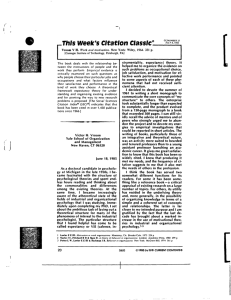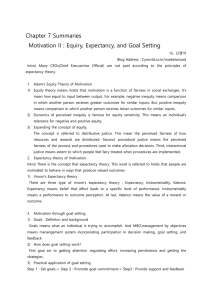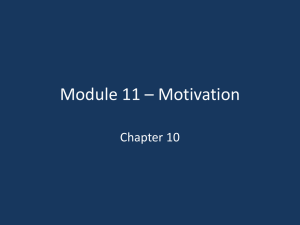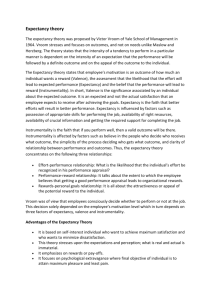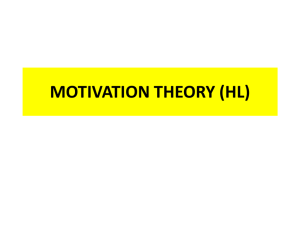Examining Motivation Theory in Higher Education: An Productivity
advertisement
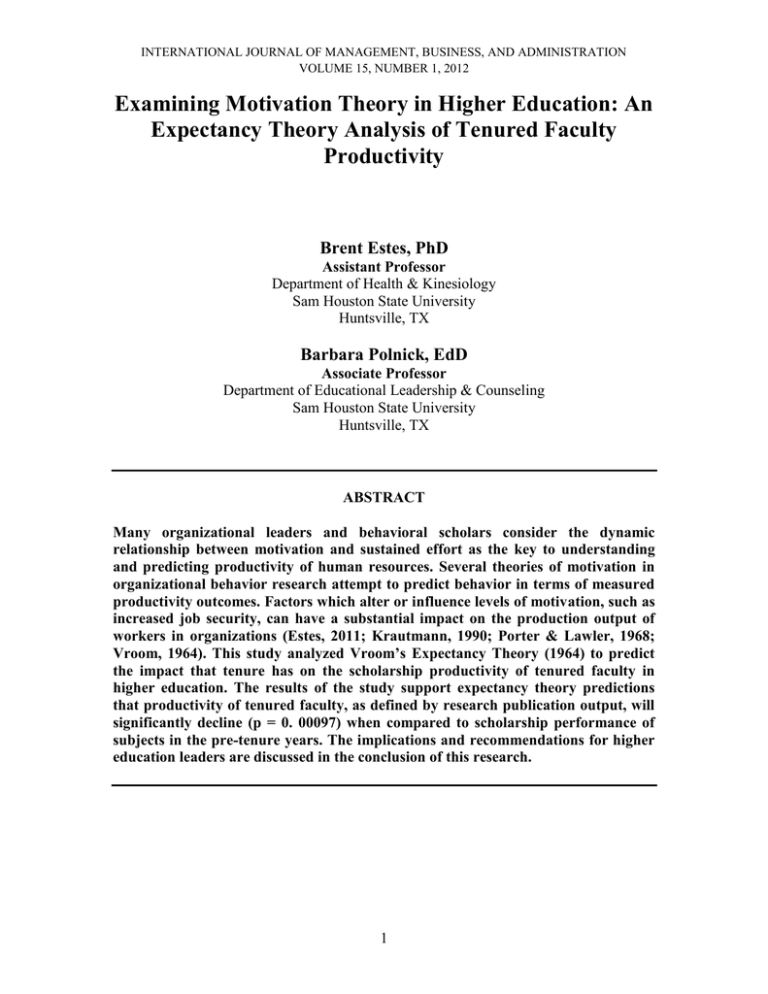
INTERNATIONAL JOURNAL OF MANAGEMENT, BUSINESS, AND ADMINISTRATION VOLUME 15, NUMBER 1, 2012 Examining Motivation Theory in Higher Education: An Expectancy Theory Analysis of Tenured Faculty Productivity Brent Estes, PhD Assistant Professor Department of Health & Kinesiology Sam Houston State University Huntsville, TX Barbara Polnick, EdD Associate Professor Department of Educational Leadership & Counseling Sam Houston State University Huntsville, TX ABSTRACT Many organizational leaders and behavioral scholars consider the dynamic relationship between motivation and sustained effort as the key to understanding and predicting productivity of human resources. Several theories of motivation in organizational behavior research attempt to predict behavior in terms of measured productivity outcomes. Factors which alter or influence levels of motivation, such as increased job security, can have a substantial impact on the production output of workers in organizations (Estes, 2011; Krautmann, 1990; Porter & Lawler, 1968; Vroom, 1964). This study analyzed Vroom’s Expectancy Theory (1964) to predict the impact that tenure has on the scholarship productivity of tenured faculty in higher education. The results of the study support expectancy theory predictions that productivity of tenured faculty, as defined by research publication output, will significantly decline (p = 0. 00097) when compared to scholarship performance of subjects in the pre-tenure years. The implications and recommendations for higher education leaders are discussed in the conclusion of this research. 1 INTERNATIONAL JOURNAL OF MANAGEMENT, BUSINESS, AND ADMINISTRATION 2_________________________________________________________________________________ In today’s higher education landscape, university administrators are faced with a plethora of challenges. Perceived success for higher education leaders and their respective institutions is contingent on a myriad of issues ranging from recruitment and retention of students to comprehensive fiscal responsibility. Ultimately, though, like most organizations, leaders must rely on the performance of their workers, faculty and staff. One could even argue that the success of a college or university is largely based on the productivity of its faculty. In that respect, higher education institutions mirror many organizations in today’s business world in terms of their need to objectively evaluate the performance of their faculty. The ability to accurately forecast and assess faculty productivity is imperative to understanding and influencing organizational success. Likewise, evaluation of faculty development in terms of skill, ability, and achievement is essential in determining an individual’s value to his/her university. Selecting appropriate means to assess faculty productivity and performance is an important step for administrators to take in their efforts to find more effective means of reaching institutional goals. Today, universities increasingly rely on performance assessments to determine salaries and tenure rewards for their faculty members. The threat of shirking duties and/or decreased productivity by tenured faculty members may become a real threat to the effectiveness of an institution. The ideology for this threat is based on the notion that once tenure is achieved, job security increases and motivation to sustain or even increase productivity is negatively affected. Previous research in motivation theory has drawn attention to the fact that productivity often suffers as a result of long-term job security. Specifically, allegations of declines in productivity due to long-term job security have been associated most with professional athletes and in the academic institution of tenure (Estes, 2011; Krautmann, 1990). Tenure has both costs and advantages for the faculty and administration, alike. For a faculty member who is denied tenure, there are a number of issues including personal, professional, emotional, and financial consequences. Likewise, denial of tenure causes a university to lose an investment in the professional development of a faculty member (Ovington, et. al., 2003). Understanding and predicting whether or not faculty productivity declines as it relates to tenure and if so, why, could prove invaluable for administrators and university leaders in finding more effective ways to evaluate and motivate faculty through informed policy decision making. This study seeks to explore issues related to motivation and tenure by identifying trends specific to scholarly research productivity by comparing publication output of pre-tenured faculty to their publication production once tenure has been achieved. Theoretical Framework Perhaps the single largest determinant of productivity among workers in all facets of life is motivation. It is unlikely that higher education faculty members are an exception. It has long been thought that by taking away the proverbial carrot, one is also taking away incentive and motivation for sustained effort. Vroom’s Expectancy Theory BRENT ESTES AND BARBARA POLNICK _____________________________________________________________________________________3 (1964) attempts to predict effort and, consequently, productivity as it relates to individual motivation. Current researchers of the Expectancy Theory of motivation draw upon the early works of several theorists, among them Victor Vroom (1964), Peak (1955), and Porter and Lawler (1968). When developing his Expectancy Theory (or VIE Theory), Vroom used the “instrumentality” conceptualizations of Peak’s (1955) Instrumentality Theory which hypothesizes that an individual’s attitude toward an outcome depends on his/her perceptions of relationships (referred to as instrumentalities) between that outcome and the attainment of various other consequences toward which he/she feels differing degrees of liking or disliking (identified as valence). In addition to instrumentality and valence, Vroom introduced the concept of expectancy into his model of motivation (Graen, 1969). Porter and Lawler (1968) extended Vroom’s work with their hypothesis that performance is a function of the interactions among instrumentality, valence, expectancy, ability, and role perceptions. The inclusion of role perceptions as an additional measure of performance distinguishes these two theories from one another (Heneman & Schwab, 1972). Role perception, as defined by Porter and Lawler (1968), includes the direction of effort, which describes the kinds of activities and behaviors the individual believes he/she should engage in to perform his/her job successfully. According to Vroom’s Expectancy Theory (1964), three perceptions (valence, instrumentality, and expectancy) can separately influence an individual’s motivation, but when combined, these perceptions can have a powerful effect. Valence refers to affective orientations (value) toward particular outcomes. An outcome is said to be positively valent for an individual if he or she prefers attaining it to not attaining it. An outcome which a person would prefer to avoid is said to be negatively valent. An outcome can be perceived as having value in itself or because of its instrumentality in achieving other valued ends. Valence is a function of an individual’s needs, goals, values and sources of motivation (Vroom, 1964). Instrumentality is the personal belief that first-level outcomes lead to second level outcomes (Porter & Lawler, 1968; Vroom, 1964). In other words, if an individual believes that a high level of performance is instrumental for the attainment of other outcomes that he expects will be rewarding (such as a pay increase, for example), and/or if he believes that a high performance level will be instrumental for avoiding other outcomes that he wishes to avoid (such as being fired), then that individual will place a high valence upon performing well. When individuals perceive that valued rewards follow all levels of performance, then instrumentality is low (Pinder, 1984). Expectancy is defined as “a momentary belief concerning the likelihood that a particular act will be followed by a particular outcome” (Vroom, 1964). This belief, or perception, is generally based on an individual’s past experience, self efficacy, and the perceived difficulty of the performance standard or goal (Porter & Lawler, 1968). Vroom (1964) suggests that expectancies, instrumentalities, and valences interact psychologically within an individual’s beliefs to create a motivational force which in turn influences behavior. Further, Vroom maintains that when deciding among behavioral options, individuals select the option with the greatest motivation forces. Vroom’s theory can be summarized as follows: Motivation Forces = Expectancy x Instrumentality x Valence INTERNATIONAL JOURNAL OF MANAGEMENT, BUSINESS, AND ADMINISTRATION 4_________________________________________________________________________________ Higher education leaders can utilize expectancy theory to understand what motivates faculty in their institutions, and how individual faculty members make decisions regarding various behavioral alternatives. For example, utilizing expectancy theory, faculty in higher education would make decisions regarding publication and research efforts based on the degree to which they value the outcomes of their efforts (valence). Understanding the degree to which faculty value these outcomes could play a key factor in predicting effort (instrumentality). According to this logic, then, understanding VIE motivational theory can help higher education leaders more accurately predict performance by knowing whether faculty believe that they can achieve success (expectancy). A number of specific assumptions regarding faculty performance need to be considered when utilizing expectancy theory in academia. These assumptions, according to Nadler and Lawler (1977), are as follows: (a) behavior is determined by a combination of forces in the individual and forces in the environment, (b) people make decisions about their own behavior in organizations, and (c) different people have different types of needs, desires and goals which can influence performance. Individuals in an organization, according to expectancy theory, make decisions to perform based on their perceptions of the likelihood that effort will lead to performance and performance will lead to desired outcomes (Vroom, 1964; Porter & Lawler, 1968). Specifically, higher education leaders utilizing Vroom’s theory would assume that “the choices made by a person among alternative courses of action are lawfully related to psychological events occurring contemporaneously with the behavior” (1964, p. 14). Overall, expectancy theory research supports the idea that individuals choose to alter inputs based on preferences among desired outcomes and the probability of attaining those outcomes at a satisfactory level. Studies have shown that each component of expectancy theory- expectancy, instrumentality, and valence- is an important factor in determining the extent to which an individual is motivated to increase or decrease productivity (Mitchell & Biglan, 1971; Nadler & Lawler, 1977; Porter & Lawler, 1968; Vroom, 1964). Ultimately, value perceptions are the strongest determinant of effort. Expectancy theory research regarding productivity as it relates to tenure in academia is limited. A research study conducted by Chen, Gupta, & Hoshower (2006), utilized expectancy theory to examine factors that motivate business faculty to conduct research and found that the value of rewards was the biggest determinant of research productivity. According Chen, et. al. (2006), faculty members who are not tenured tend to be motivated by extrinsic rewards, while tenured faculty tend to be intrinsically motivated with respect to conducting research. In addition to personal motivation of faculty, other dynamics can certainly influence research productivity. Specifically, the Life-Cycle theory (Hu & Gill, 2000), supports expectancy theory predictions by positing that research productivity often rises sharply in the initial stages of a faculty member’s pre-tenure academic career, ultimately peeking at the time of tenure review, and eventually declining once tenure has been attained. The current study will utilize the expectancy theory framework to predict research productivity of education faculty between pre-tenure and post-tenure years. BRENT ESTES AND BARBARA POLNICK _____________________________________________________________________________________5 Purpose of the Study The purpose of this study was to measure the research productivity of higher education faculty as it relates to motivational theory. Specifically, the researchers analyzed the applicability of Vroom’s Expectancy Theory as a predictor of post-tenure faculty productivity. The authors describe how higher education leaders can utilize expectancy theory to understand post-tenure faculty performance with respect to research/scholarly publications. Knowing whether or not faculty production may or may not decrease following the award of tenure can be of value to higher education leaders. For example, the reduction of merit as a way to meet fiscal challenges may or may not impact post-tenure faculty research productivity. The study explored the motivational value of external rewards as they relate to increasing productivity. Methodology Pre-tenure and post-tenure data determining research productivity levels of tenured faculty members (N=24) were collected from the College of Education at a Research One University in Southeast Texas in order to ascertain whether expectancy theory predictions hold true as it relates to tenure and productivity in academia. Productivity was operationally defined as scholarly research activity in the form of published journal articles. This study evaluated research productivity for three years “pretenure” and three years “post-tenure” for each eligible faculty member. All data analyses were performed using SPSS version 10.0 (SPSS, 1999). A paired t-test was conducted to determine if there was a significant difference between pre-tenure and post-tenure productivity of the aforementioned subjects, and, subsequently, whether expectancy theory predictions are true based on the following hypothesis: H1: Research productivity of faculty, as measured by scholarly publication output, will decline in the post-tenure years when compared to the pre-tenure years. Limitations The study was subject to the following limitations: 1. The study focused exclusively on faculty members in the College of Education at a Research One University in the South, and the results may not be representative of faculty member productivity in other colleges or at other institutions. 2. Since there is no universal objective measure of scholarship quality in terms of research productivity among higher education faculty, this study relied only on the quantitative output of scholarship in the form of peer-reviewed research publications. Hence, it is possible that while the number of publications may INTERNATIONAL JOURNAL OF MANAGEMENT, BUSINESS, AND ADMINISTRATION 6_________________________________________________________________________________ have declined for some faculty members, the quality of their research improved. 3. Productivity declines by post tenured faculty may be attributed to increased effort and/or improved outcomes in teaching and/or service. Results and Conclusions Of the 24 faculty members studied over a three year period of pre- and posttenure, researchers found a statistically significant (p=0.00097) decline in research publications for tenured faculty. This represented a 42% reduction in scholarly publications. The results of this study are consistent with expectancy theory predictions that faculty members’ productivity may decline as a result of attaining tenure. This study validated expectancy theory predictions that research productivity declines in post-tenure years when compared to pre-tenure output, and confirms the need to further investigate the impact that long-term job security, in the form of tenure, has on faculty productivity in higher education. Specifically, the findings from this study support expectancy theory predictions that faculty effort is most affected by valence perceptions. In other words, since tenured faculty members have already achieved a level of research success, it is unlikely that productivity declines could be attributed to one’s doubt in his or her ability to publish research (expectancy). Likewise, it is unlikely to assume that tenured faculty members place no value on research productivity (instrumentality). Rather, the decline in research output can be attributed to a faculty member’s value perceptions toward higher sustainability of published research (valence). This is of particular importance to university administrators and leaders throughout higher education since it indicated that declines in productivity can be attributable to the idea that faculty members simply do not value the outcomes from sustaining higher levels of productivity, thus negatively affecting their motivational force. This study is just the first step in determining and predicting motivational behavior of tenured faculty in higher education. Future research could substantiate this idea by assessing tenured faculty members’ attitudes toward research productivity. Also, assessing a multi-dimensional definition of productivity in terms of not only research, but teaching and service as well could prove beneficial to understanding motivation and preventing shirking among tenured faculty in higher education. Recommendations for Administrators in Higher Education Institutions The following recommendations are offered as possible next steps to applying expectancy theory to faculty motivation and productivity: 1. Conduct analysis of faculty productivity both pre- and post-tenure; 2. Form focus groups to study the application of expectancy theory to faculty production; BRENT ESTES AND BARBARA POLNICK _____________________________________________________________________________________7 3. Interview faculty regarding possible motivators for increased or decreased productivity, including faculty who failed to attain tenure and/or have left the institution; 4. Review current policies and practices regarding performance assessments of faculty for effectiveness in providing sustained professional growth as they relate to expectancy motivational theory; and 5. Work to operationalize merit and tenure guidelines to include motivational elements as described in expectancy theory that may have an impact on recruiting and retaining quality faculty. References Chen, Y., Gupta, A., & Hoshower, L. (2006). Factors that motivate business faculty to conduct research: An expectancy theory analysis. Journal of Education for Business, 81, 179-189. Estes, B. C. (2011). Predicting productivity in a complex labor market: A sabermetric assessment of free agency on Major League Baseball player performance. Business Studies Journal, 3, (Special Issue 1), 23-58. Graen, G. (1969). Instrumentality theory of work motivation: Some experimental results and suggested modifications. Journal of Applied Psychology Monograph, 53, 125. Heneman III, H. G., & Schwab, D. P. (1972). Evaluation of research on expectancy theory predictions of employee performance. Psychological Bulletin, 78, 1-9. Hu, Q., & Gill, T. G. (2000). IS faculty research productivity: Influential factors and implications. Information Resources Management Journal, 13(2), 15-25. Krautmann, A. C. (1990). Shirking or stochastic productivity in Major League Baseball? Southern Economic Journal, 14, 961-968. Mitchell, T. R., & Biglan, A. (1971). Instrumentality theories: Current issues in psychology. Psychological Bulletin, 76, 432-454. Nadler, D. A., & Lawler, E. E. (1977). Motivation: A diagnostic approach. In J. R. Hackman, E. E. Lawler, & L. W. Porter (Eds.), Perspectives on behavior in organizations (pp.26-34). New York, NY: McGraw-Hill. Ovington, J., Diamantes, T., Roby, D., & Ryan. C. (2003). An analysis of prevailing myths regarding tenure and promotion. Education, 123(3), 635–637. Peak, H. (1955). Attitude and motivation. In M. R. Jones (Ed.), Nebraska symposium on motivation. Lincoln, NE: University of Nebraska Press. Pinder, C. C. (1984). Work motivation. Glenview, IL: Scott Foresman. Porter, L. W., & Lawler, E. E. (1968). Managerial attitudes and performance. Homewood, IL: Irwin-Dorsey. SPSS. (1999). SPSS base 10.0 for Windows user's guide. Chicago, IL: Author. Vroom, V. H. (1964). Work and motivation. New York, NY: Wiley & Sons.

